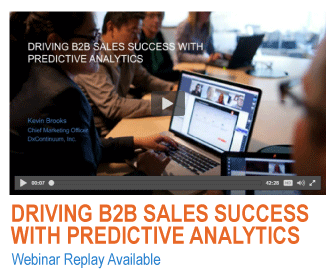Predictive lead scoring is all the rage with digital marketers these days with many vendors making many promises. Some promise to scrape the internet for 1000s of signals to rank prospective leads to uncover the most “ready-to-buy” prospects by discovering “hidden buying triggers”. Others promise to boost sales efficiency by qualifying leads in bands, claiming that top scoring leads qualify at 4X the baseline and that 95% of opportunities came from these leads.
The main use for these predictive lead scores is that they enable marketers to cull leads that are ineffective thereby increasing conversion rates. However, in our experience, customers want a balance between using the score to decide whom not to call because they are unqualified leads, and ensuring that they don’t leave behind leads that should have been qualified. Many vendors who claim to increase conversion rates do not provide any evidence of maximizing conversions. Top scoring leads converting at 4X baseline is not as attractive if the scoring solution is too conservative and leaves money on the table.
We recently got an opportunity to go head-to-head with one of our competitors at a cloud-based communications company. This competitor (called "Comp" below) adds 1000s of account-level buying signals to create the predictive model. Alternatively we used the historical data that was available in their CRM system augmented with minimal additional signals to create our predictive model (see http://www.dxcontinuum.com/index.php/blog/predictive-buying-signals-less-is-more/). After being deployed in production for 90 days, we have the necessary outcome data to compare the actual predictive performance of the two approaches.
If the scoring is predictive of outcome, more leads that actually converted to opportunities will get high scores. In the chart below we plotted the number leads that actually converted into opportunities by their scores in 10 uniform score buckets (deciles). So if the scores were from 1-1000, decile1 was 1-100, decile2 was 101-200, etc.
Our competitor scored more leads that actually qualified in the lowest decile, which means that they are least likely to qualify! On the other hand, we scored the maximum number of leads that actually qualified in the highest decile. Our competitor’s score is inversely correlated with actual conversion, whereas our score is positively and strongly correlated with actual conversion. This means that this customer cannot use our competitor’s score to actually make the decision to call a lead or not because they would be leaving way too many good leads out of mix.
No predictive model is perfect, but if the model is using the right signals that represent the conversion process, the model will score most leads that actually qualify in the higher deciles. If the scores are used to decide whom to call, identifying and discarding bad leads will increase conversion rates. However, not maximizing actual conversions by dropping leads that could have actually qualified, leaves money on the table. In other words, unless your predictive lead scoring solution can maximize both conversion rates as well as actual conversions, it is like flushing money down the drain.
So, is your predictive lead scoring investment optimizing your money making capability or is it leaving money on the table?
If you are using DxContinuum’s lead scoring solution the answer is a resounding YES to optimizing your money making capability!
This is because DxContinuum’s patent pending predictive analytic platform can use the signals that actually drive conversion and automatically generates the best predictive model that maximizes both actual conversions and conversion rates.






